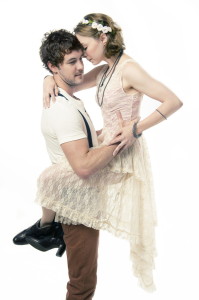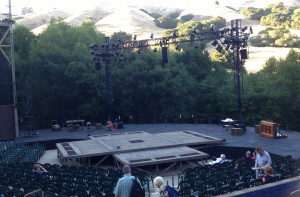Review: ROMEO AND JULIET at CalShakes
July 8, 2013 § 2 Comments
Can it be that the most “authentic” production of a Shakespeare play I’ve seen in years is a modern-dress production of Romeo and Juliet with a cast of seven performing a heavily cut text, accompanied by a pulsing club-inspired sound design? To my great surprise, I believe so.
As a professor of both acting and theater history, I think a lot about what the experience of seeing an original performance of a Shakespeare play must have felt like. It is the effect that I would most want to capture, not the form. We can do a reasonably good job at recreating the look and style of the late sixteenth century theater, but what would have been innovative, contemporary, and engaging then often seems hopelessly stale and distant now that the context has completely changed.
Shana Cooper’s Romeo and Juliet, now playing at the California Shakespeare Theatre near San Francisco, is a stark but simply brilliant, production. It is as far from a museum replica version as possible, yet it recreates all of the Shakespearean theater’s virtues in modern form.
Played on an open stage against no scenic backdrop but the Orinda, Ca. landscape behind CalShakes’ outdoor auditorium, Cooper uses a text-based technique right out of the Elizabethan theater to verbally move us instantly from imaginary location to location on Daniel Ostling’s aggressively thrusting platform set. The visual neutrality focuses all attention on the action, but when it pauses to be beautiful it is breath-taking. Romeo defying stars that you can actually see causes an exhilarating, visceral rush. Lap Chi Chu’s lighting design for the stage is effective, but his subtle lighting of the natural background in the distance, particularly in the eerie tomb scene, is genius.
Performed by an incredibly versatile cast of three women and four men playing some twenty roles in a heavily but skillfully edited version, it was energetically engaging for every moment of the promised (accurately, for once) two hours traffic on the stage. Somewhere between a quarter and half of the traditional text was excised, including all the bit parts. In clumsy hands, that might have given the appearance of financial expediency, but here it focused and sped the narrative so that events felt – as they should – like they were spinning out of control. Early in the second half the scenes in which Romeo and Juliet separately learn he has been banished were intercut in a way that seem stunningly cinematic or, well, Shakespearean. The juxtaposition of the simultaneous scenes was inspired.
The modern dress costumes enhanced the youthful, often rude energy of the performances. Although the period was changed to some quasi-now (where fourteen-year-olds can still be married off at a father’s whim), it read less as a resetting and much more a case of simply becoming invisible to us. I suspect this is the way that contemporary dress on the Elizabethan stage might have affected the Shakespearean audience – it faded into the background, as neutral as the scenery.
The performances were uniformly outstanding. Rebekah Brockman was an unusually aggressive Juliet from her first entrance when she jumped out to frighten the nurse. She has just finished a run of the season’s best production, playing Thomasina in ACT’s Arcadia. Perhaps it is because she was so indelible in that role that she seemed to possess the same combination of tragically under-appreciated intelligence and irrepressible, emerging sexuality here, but it is more probable that she carried it forward to create an equally self-inventing Juliet.

Dan Clegg (Romeo) and Rebekah Brockman (Juliet) in Cal Shakes’ Romeo & Juliet, directed by Shana Cooper; photo by Kevin Berne.
Romeo can be one of the least rewarding roles in the canon. He works incredibly hard in the first half of the play and then slowly fades from view in the second as Juliet’s story eclipses his. Dan Clegg brought unusual charm and skill to the part, and greatly benefited from the extensive cutting of Romeo’s mopiest and dopiest moments. He emerged as a genuinely tragic figure in the tomb scene, most moving when he unsuccessfully sought to scare Paris away to avoid killing him.
The other five cast members all played multiple roles with theatrical verve that made the production electrifying. Nick Gabriel (another veteran of the Arcadia cast) played Tybalt and Paris as entitled hipsters. Domenique Lozano doubled the Prince of Verona with the nurse, and excelled at both parts of this unlikely pairing. Arwen Anderson was a mousy Lady Capulet, but revelatory as Benvolio, where she out-guyed the guys when being one of the guys. Joseph J. Parks was the engine of the first act as the relentlessly and inappropriately libidinous Mercutio. It is, of course, necessary that this comic presence disappear from the last half of the play, and Parks is too irrepressible to hide effectively, but it is too bad that he could not be used for more than a cameo as the apothecary after intermission. He is too good to sacrifice.
The production ultimately rests on the skills of Dan Hiatt, who is onstage almost continuously in the second half as Friar Laurence, quick-changing into Lord Capulet, and then reappearing as the servant Peter. That he could walk to the edge of the platform, slip on a jacket, and return instantly as someone else for scene after scene was a confirmation of what every regular theater-goer in the Bay Area already knows: he is a consummate actor. It is worth the price of admission just to watch his transitions.
The production is so tightly focused, suiting the action to the word and the word to the action, that it is immediately affecting while serving as a model of narrative clarity. One might quibble with the unusual choice to strangle rather than stab Tybalt, only because it renders later references to shedding his blood very odd, but Shana Cooper’s direction is otherwise flawless. The fast-moving staging, stylized fights, smart transitions and beautiful use of the natural surround as scenery combined for the most rewarding (and least gimmicky) Shakespeare I’ve seen in ages. It was fresh and exciting.
I walked away thinking, “I bet that is exactly how it felt at the Globe.”
